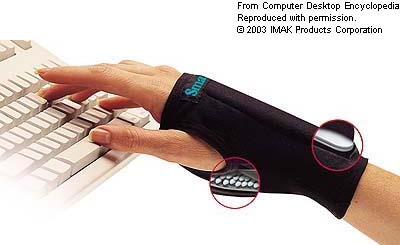
Neri Oxman gave a talk, “Mediated Matter,” at the Ontario College of Art and Design. She claimed that material should not be secondary to form. Instead of separating fabrication from concept modeling or data analysis, she proposed, designers should create a seamless object by integrating these tasks. She presented interesting projects in which she used a single material to perform multiple functions. Her work was heavily inspired by nature.
One of her interesting projects is a medical device for those who suffer from Carpal Tunnel Syndrome. This syndrome is a medical condition in which the median nerve is compressed at the wrist, leading to numbness, muscle atrophy, and weakness in the hand. At present, most patients are recommended to wear gloves that are composed of two separate materials which perform different functions; a soft cushion and a hard metal (see left). As an alternative, she developed a “skin” with a single material by mapping the pain-profile and distributing hard and soft materials to fit the patient’s anatomical and physiological requirements, limiting movement in a customized fashion (see right). Her project is called as Carpal Skin.
Overall, her argument is interesting; designers may produce a better product when they perform a series of design tasks simultaneously (e.g., selecting a form and materials together) than when they go through the same tasks sequentially (e.g., selecting a form and then selecting materials).

